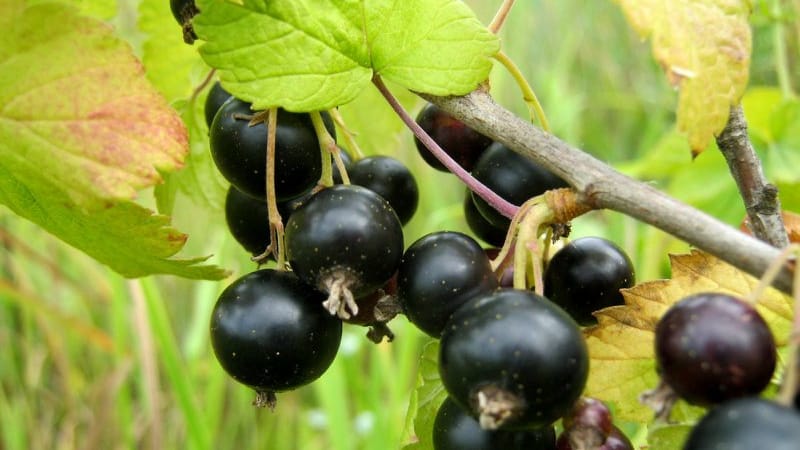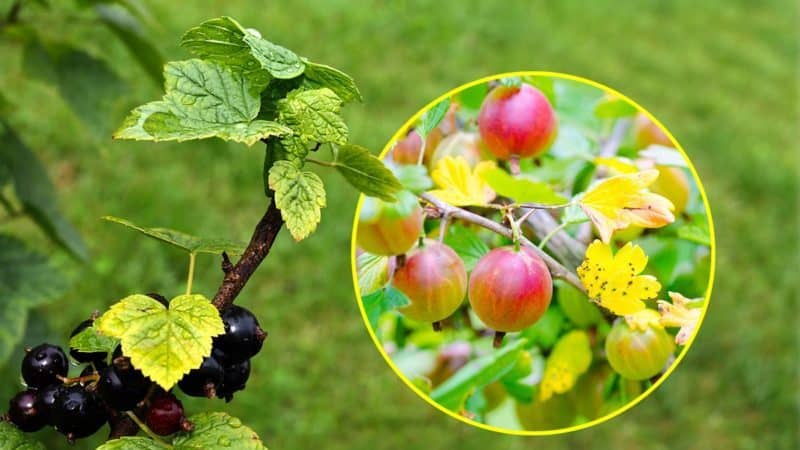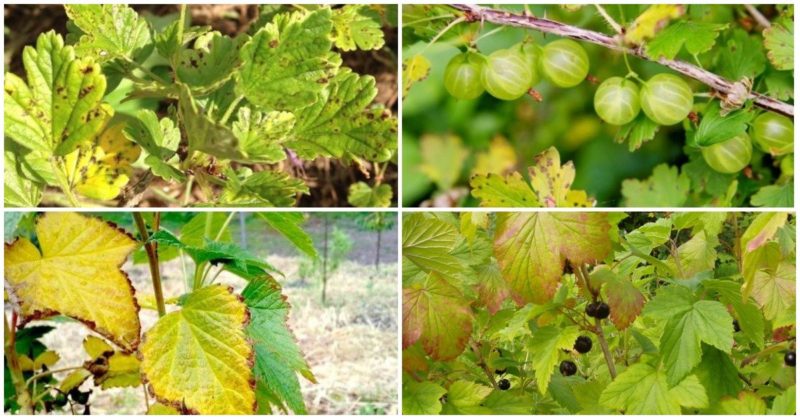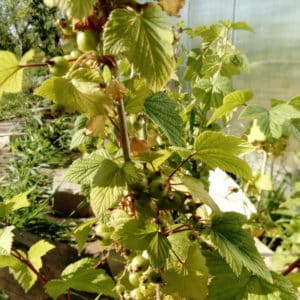Currant leaves turn yellow in June: why does this happen and what to do in this case
One of the signs of a healthy plant is leaves that are bright and rich in color. A change in shade and deformation of the leaf plate indicate improper care, but more often it is a sign of disease or pest activity.
We will tell you why the leaves turn yellow currants in June and what to do in this case - immediately use chemicals or use traditional methods.
Yellowing of leaves during drought in June
Early yellowing of leaves can be due to many factors. One of them is weather and climatic conditions (sudden temperature changes, prolonged precipitation, etc.).
Let's talk in detail about other reasons - those that the gardener can eliminate on his own.
Deficiency or excess of nutrients
Currants turn yellow and dry out, often due to improper fertilizing. Deficiency or excess of one or another element is determined by external changes in foliage:
- Magnesium. Yellowing of the leaves in the lower part of the bush indicates a lack of magnesium. In this case, the veins remain green, and the leaf blade turns yellow. The problem can be corrected by feeding the plant with dolomite flour, wood ash or magnesium sulfate.
- Potassium. Potassium deficiency manifests itself in yellowing of the leaves along the edges, while the blade and vein remain green. You can compensate for the deficiency of the substance with potassium sulfate, potassium chloride or potassium magnesium.If the leaf curls down but does not fall off, this indicates an excess of the mineral.
- Nitrogen. With a lack of nitrogen, the shoots stretch out, become thin, and fall off prematurely. The leaf blade loses color, only the veins remain green. The addition of mineral (urea, calcium nitrate, dolomite flour + ammonium nitrate) or organic (poultry droppings, pig/horse/cow manure) forms of nitrogen will eliminate the problem. With an excess of the mineral, the leaves become brittle and have a rich green color.
- Iron. If there is insufficient iron in the soil, the leaf blade begins to turn yellow and its edges dry out. They compensate for the deficiency of the element by applying iron sulfate at the root and iron chelate as a foliar feeding. An excess of the element is determined by limp leaves with light veins.
The norm of potassium per year for young bushes is 30 g, phosphorus - 40 g.
Poor or excessive watering
Lack of moisture, as well as its excess, is dangerous for the plant. With prolonged drought and insufficient watering, the plant signals a lack of water with yellow leaves.
But in conditions of constant humidity, the root system begins to rot. Therefore, it is important to follow watering standards. Depending on the climate, 1-2 buckets of settled water are required for each bush. This amount is enough to moisten the soil by 40-60 cm and avoid rotting of the root system. The frequency of watering is 2 times a month.
Lack of loosening and improper planting

In order for soil moisture to occur at the required level, the soil is maintained in a loose state without a surface crust. To do this, the soil is loosened once every 15-20 days. Next to bushes this is done no deeper than 8 cm, and in row-spacings - to a depth of 12 cm.
There is a close relationship between the growth of the root system and the development of the foliage apparatus of the aboveground part of the plant. Therefore, the health of the plant depends on the depth of soil cultivation and the time of planting seedlings. If you plant seedlings before return frosts, during the growing season the young plants will have yellow foliage, and the chances of survival of the bushes will be low. For better rooting, currants are planted in the fall, and for the winter they are insulated with burlap or spunbond.
A shallow planting hole prevents the full development of roots. To avoid the problem, it is necessary to deepen it.
For reference. Bushes may turn yellow due to old age - at the age of more than 15 years.
Pests and plant diseases
If the above-described causes of yellowing of currant leaves are easy to eliminate, then if diseases or pests it will take more effort.
Yellowing of currant leaves is one of the symptoms diseases:
- Rust. The disease appears as yellow-orange warts on the bottom of the leaf or small red spots. Over time, the leaves and berries dry out and fall off.

- Anthracnose. Circular brown spots are visualized on both sides of the leaf, which eventually merge into yellow. Uncharacteristic foliage color indicates the final stage of the disease.
- Mosaic. The appearance of pale yellow spots indicates the initial stage of a viral disease. Over time, the leaf turns completely yellow, the affected tissue between the veins turns white and dries out.
- Verticillium. Weak growth of shrubs and yellowing of leaves, their shedding from the lower tier indicates a lack of nutrients, since Verticillium wilt affects the root and vascular systems of the plant.
Some yellowing of leaves may be caused by powdery mildew, or sphere library.
It is recommended to promptly remove yellowed leaves, dig up and burn severely damaged plants, and use “Fitosporin-M” or “Agrolekar” fungicides for treatment.
How to control pests
The appearance of harmful insects on the plant is also accompanied by yellowing of the leaves. Moreover, this is not the only symptom - depending on the pest, the signs vary.
It is not difficult to determine the activity of insects; just carefully examine the bushes. The peak of pest invasion occurs during flowering and fruit formation.
Gall aphid
Aphids spoil currant leaves until mid-July, after which they move to other plants. In autumn, the insect lays eggs on branches, where they overwinter safely and hatch in early spring.
The presence of aphids is determined by brown and yellow swellings on the upper part of the leaf blade. Over time, the tubercles darken and the leaves dry out. If you look closely, you can see small, almost transparent insects on the affected areas.
It is important to promptly notice any changes in the leaf mass of the plant. At the first spots of deformation, the bush is doused with water brought to a boil. Most gardeners use this method even before the leaves appear to destroy laid insect eggs.
If the leaves are slightly damaged (4-5 pieces), they are torn off and burned outside the site. If damage is noticed on one branch and the tubercles are swollen on most of the leaf blades, then the branch is cut off and the cut is treated with paint or garden varnish.
For reference. Gall aphids damage black currants to a lesser extent. Insects prefer colored varieties, because their leaves are thinner, and it is easier for the pest to pierce them and extract juice.
Traditional methods
The most common method is to treat plants with boiling water. After the water boils, it is poured into a watering can with a diffuser and poured over the bushes. After dousing, treat the trunks with lime - this will continue to destroy aphid eggs.
Other folk remedies:
- Baking soda solution. To prepare the solution, prepare a soap base: rub laundry soap on a grater at the rate of 40 g per 10 liters of water. Add sodium bicarbonate (2 tablespoons per 1 liter) to a warm soap solution. The plant is treated in early spring, before the buds open.
- Laundry soap. The product is used if aphids have just appeared on the bushes. Grate 1.5 pieces of laundry soap and dissolve in 2 liters of warm water. 8 liters of water are added to the resulting concentrate. Strain before use and spray.
- Decoction of celandine. 4 kg of crushed celandine is poured into 10 liters of water and allowed to brew for 4-5 hours. The liquid will turn dark brown. Strain and begin processing the bushes.
Use of biological products
Pests are controlled in large quantities with insecticides and biological products. The latter do not harm the plant and are safe for human health, so they are actively used during the fruiting period. The most effective biological products:
- "Aktofit". Pests die 3-8 days after treatment. Consumption rate: 2 ml per 1 liter of water. The required dose is poured into 0.5 liters of water, stirring constantly. The resulting mother solution, while stirring, is poured into the sprayer tank filled ⅓ full. Then close it, shake vigorously 2-3 times and immediately begin processing.
- "Fitoverm". The death of insects occurs 2-3 days after the initial treatment of the plant. Used as pests appear during the growing season.2-3 treatments with an interval of 5-7 days are enough. Consumption of the drug: 2 ml per 1 liter of water.
Application of chemicals
The drugs do not act immediately; the aphids die over time. After rains, re-treatment is required. The berries are harvested 5 days after the last spraying.
Chemicals are used as a last resort, when aphids have attacked in large numbers and other methods have not worked. Among modern insecticides, gardeners identify the following:
- "Aktellik". A product with a high rate of destruction and suppression of pests. Dosage: 1.5-2 ml per 1 liter of water. Twice treatment with an interval of 5-7 days is sufficient. Compatible with biological products.
- "Biotlin." Similar to Aktellika, but more affordable. The manufacturer guarantees the death of pests within 3-4 hours. The working solution is prepared by diluting the concentrate first in a small amount of water (0.5-1 l), and then adding water to the required amount. Consumption rate depending on the size of the bush: from 0.5 to 1.5 liters per bush.
When spraying with chemicals, use protective clothing, a mask and gloves. Do not use during fruiting period. Harvesting begins no earlier than 20-30 days after the last treatment.

Glassware
These are whitish caterpillars with a black head.. They appear at the end of June and immediately try to penetrate inside the shoots. The pest prefers young bushes, mainly black currants. Rarely seen in other species. The caterpillars move along the entire shoot down to the root, gnawing out the core and leaving a hollow space. If you make a longitudinal cut on a branch, you can see a passage with excrement or the caterpillar itself.
Damaged shoots stop growing, dry out and break off. There are very few berries, they taste sour.The caterpillar overwinters in the branches themselves, therefore, in order to prevent the life cycle of the pest in their area, a set of measures is carried out.
If a pest is detected, all dry shoots are cut off and destroyed. Pruning carried out throughout the growing season.
In early June and throughout the growing season, they fight with adult butterflies. After their number decreases, the number of larvae also decreases. Prevention is carried out with biological insecticides “Fitoverm Forte”, “Bitoxibacillin”. Plants and the root area are treated at intervals of 7-8 days.
For reference. Butterflies appear in the second half of June. In order not to miss the moment, traps with sweet syrup or fermented jam are placed near the currants. Plant processing begins immediately as soon as at least one of the adult individuals falls into the trap.
Chemicals
Biological insecticides are good only as a preventive measure. Only chemicals will help in pest control. When the buds begin to open, the bushes are treated with Karbofos. Also, before currant blossoms, Inta Vir is used. Procedure:
- "Karbofos". A 10% solution of the drug is suitable for eliminating glassware. Use a suspension or water-soluble powder. When processing berry crops, irrigation is more often used. The first treatment is carried out in early spring, the second after flowering. Consumption rate: 30 g per 4 liters of water. 1-2 liters is enough for one bush.
- "Inta Vir". Available in tablets. For 10 liters of warm water, 1 tablet is enough. First, prepare a mother solution: the crushed tablet is diluted in 300 g of water, then another 700 g is added and stirred. Then add water to the required level, shake it up and begin irrigation.
In parallel with currants, raspberry bushes are also processed, since adult individuals prefer the pollen of this berry crop.
If complex measures are not successful, the damaged bush is cut off at the root and burned.
Traditional methods
These methods are more aimed at repelling adults. It is useless to use any available means to combat glassware.
To deter them, small pieces of rags are soaked in gasoline and hung on bushes. The pungent odor overpowers the smell of currants, and butterflies cannot detect them. Red or yellow cardboards are also used as bait; jars of molasses are placed under them. Bright colors attract butterflies, but they can't latch onto the cardboard and fall into jars of sticky substance.
Spider mite
The appearance of a thin gray spider web, yellowing and wilting of leaves, weakening of bush growth are signs of a spider mite invasion. Due to its small size, this dangerous pest is difficult to notice in time. The infection usually begins on the lower leaves of plants and then spreads upward. The oldest leaves are inspected for spotting, and larvae and adult mites are looked for on their undersides.
Timely detection of ticks is crucial for reducing the pest population and further effectiveness of treatment. The period of active reproduction occurs in the second half of spring.
Chemicals
Spider mites belong to the class of arachnids, and not insects, as is commonly believed. Therefore, using insecticides to control pests is a mistake. Acaricides and insectoacaricides have a detrimental effect on ticks. Usually two treatments per season are sufficient, excluding currant flowering time.
Attention! Treatment with chemicals is carried out in dry and windless weather, using protective clothing and a mask.
Effective drugs:
- «STOP tick." The product acts at all stages of insect development, destroying them within the first minutes after treatment. The drug also has a long period of protective action and does not affect the growth and development of plants. Consumption rate: 7 ml per 5-6 liters of water.

- "Envidor." The action is aimed at all stages of pest development. Due to its high adhesion, the drug can be used in rainy weather. Consumption rate: 2-3 ml per 5 liters of water. Used on fruit and berry bushes twice per season, no later than 20 days before harvest.
- "Sunmite." Effective not only against ticks, but also against other insects. The best time for treatment is the period of active flowering. It has absorbent properties, so it does not require re-treatment after precipitation. To eliminate pest resistance to the active substance, apply one treatment per season. Consumption rate: 5 g per 5 liters of water.
Biological drugs
Biological products are also effective. For targeted control of ticks, the following are used:
- "Bitoxibacillin." It is most effective at the larval stage of pests. Powder consumption rate: 80-100 g per 10 liters of water. The last irrigation is 5 days before harvest.
- "Phytoseiulus". A preparation containing live predatory mites that eat spider relatives. With a rapidly growing pest population, 20-50 individuals of predatory mites per 1 m² are evicted every 14 days. After the spider mites are destroyed, the biopredator dies.
Folk remedies
The fight with folk remedies comes down to spraying currants with caustic compounds with a repellent odor:
- Garlic extract.Chop 5 cloves of garlic, add 1 liter of cold water and leave for 10-12 hours until air bubbles appear. Then filter, dilute the extract in equal proportions with water and carefully spray on the bushes. Repeated procedure – after 20-21 days.
- Tobacco infusion. 250 g of dry leaves, dust or crumbs are poured into 2.5 liters of hot water and infused throughout the day. Strain, add another 0.5 liters of water and 20 g of crushed laundry soap for better adhesion of the product to the leaves.
- Herbal infusion. Prepared from calendula, wormwood, celandine. For 10 liters of hot water, take 100-120 g of herbal raw materials of your choice and let it brew for 2-3 hours. Strain before irrigation.
To suppress the vital activity of ticks and prevent their development, colloidal sulfur or aqueous-alcoholic infusion are also used.
Prevention measures
Preventive procedures are carried out in the fall so that pests do not have a chance to lay eggs:
- If the bush is affected by pests, additional treatment with insecticides is carried out in the fall. Preventive spraying is possible in the spring before the buds open.
- Sanitary and regulatory pruning is required. All branches that thicken the bush must be removed. Sick, dried out, weak stems must be cut off. After the procedure, the sections are lubricated with garden varnish - this reduces the likelihood of harmful microorganisms penetrating into the stems.
- After leaf fall, the crown is watered abundantly, the trunk circle is carefully loosened so as not to touch the surface roots. Sprinkle with wood ash, mustard or ground pepper.
- All yellowed leaves are collected and burned.
- Strong-smelling plants - garlic, onions, calendula - are planted near the bush.
To prevent the penetration of larvae into the bark, all maintenance work is carried out as carefully as possible so as not to damage it.
Conclusion
Pests often appear as the growing season begins, but gardeners notice their presence when plant leaves turn yellow and wilt. A thorough inspection of the bushes allows you to prevent the proliferation of pests and take timely measures to preserve the harvest. In most cases, you can get by with biological drugs that are non-toxic and safe for humans.